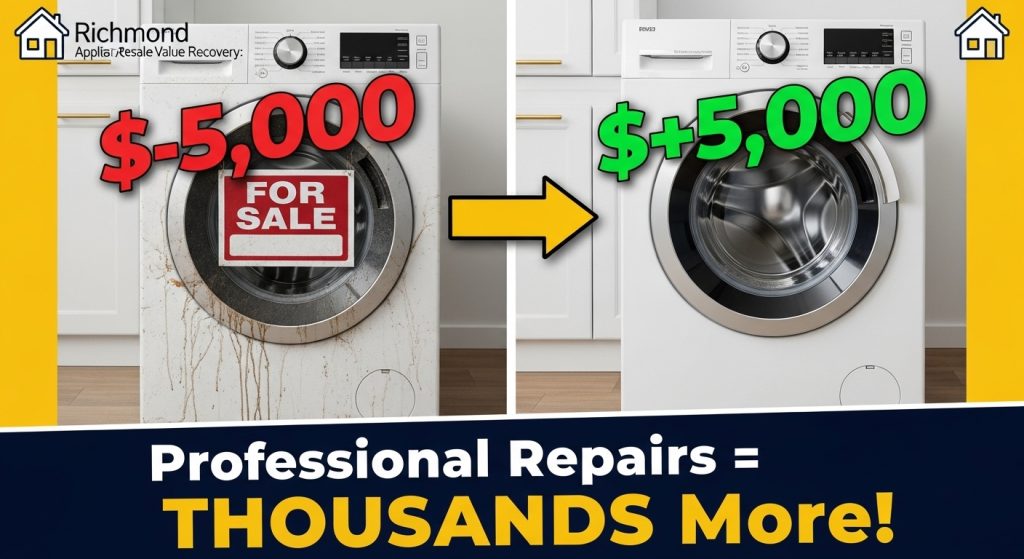Planning to sell your Richmond home and wondering if those broken appliances are actually costing you thousands? The truth is, non-functioning refrigerators, wonky ovens, and tired dishwashers don’t just turn off buyers—they actively tank your property’s market value in ways that might shock you.
Picture this: you’ve spent weeks decluttering, painting walls in trendy neutrals, and perfecting your curb appeal. But then potential buyers walk into your kitchen and immediately notice that your dishwasher sounds like a dying whale, your oven door won’t stay closed, and your refrigerator is making those concerning gurgling noises. Suddenly, all your hard work feels pointless because buyers are mentally calculating repair costs instead of imagining their morning coffee routine in your beautiful space.
Here’s the thing about Richmond’s current real estate market—we’re in a buyer’s paradise with inventory up nearly 19% year-over-year. That means your home is competing against a sea of other properties, and buyers have the luxury of being picky. When they can literally walk away and view three more houses that afternoon, why would they choose the one with obvious appliance issues? The psychology is brutal but simple: broken appliances signal neglect, and neglect makes buyers wonder what else might be wrong with your home.
But here’s where it gets interesting (and honestly, kind of exciting). Strategic appliance repairs before listing can add thousands—sometimes tens of thousands—to your final sale price. We’re not talking about gut renovations or fancy smart home integrations. Simple, professional repairs that get your appliances functioning properly can transform buyer perception and eliminate those dreaded post-inspection negotiations that typically chip away at your profits.
Key Outtakes:
- Professional appliance repairs before listing typically generate 60-80% ROI, with some energy-efficient upgrades returning 75-100% of investment through increased sale prices
- In Richmond’s current buyer’s market, functioning appliances serve as critical competitive differentiators that separate quick-selling properties from those languishing with mounting carrying costs
- The “50% rule” guides repair vs. replace decisions: if repair costs exceed 50% of replacement cost AND the appliance is beyond expected lifespan, replacement typically offers better value
- Kitchen appliances (refrigerator, range, dishwasher, microwave) deserve highest priority as they’re most visible to buyers and most thoroughly inspected during home tours
- Professional cleaning and minor cosmetic refurbishment of appliances often costs $150-300 but can generate $2,000-5,000 in improved buyer perception

How Broken Appliances Actually Tank Your Home’s Market Value
Let’s get real about what happens when buyers encounter non-functioning appliances in your Richmond home. The damage goes way beyond the actual repair costs, and it happens faster than you’d think. Within minutes of entering a kitchen with obvious appliance issues, buyers start playing a mental game of “what else is wrong here?” A broken dishwasher doesn’t just mean they need to replace a dishwasher—it signals that the entire home might have underlying maintenance problems.
This psychological phenomenon, known in real estate circles as the Halo Effect, works both ways. Well-maintained appliances suggest that you’ve been a conscientious homeowner who’s stayed on top of maintenance throughout the property. But broken appliances trigger the opposite assumption. Buyers start wondering about the electrical system, the plumbing behind the walls, and whether that HVAC system they can’t see is also falling apart.
The financial reality hits even harder during home inspections. Richmond’s inspection protocols specifically include testing built-in appliances like ranges, dishwashers, refrigerators, and microwaves. When inspectors discover non-functional units, these issues become official documentation in the inspection report. That documentation becomes powerful leverage for buyers in post-inspection negotiations. We’re talking about price concessions that typically range from 100-150% of the actual repair costs because buyers factor in inconvenience, contractor coordination, and the possibility that repairs might reveal additional problems.
Consider this scenario that plays out constantly in Richmond listings: Your home is priced at $425,000, and you receive an offer at $420,000. During inspection, the buyer discovers your refrigerator isn’t cooling properly and your dishwasher has a broken pump. The repair costs might only be $450 total, but the buyer negotiates for a $1,200 credit “to handle the appliance issues.” You just lost $750 in profit because you didn’t invest $450 in repairs before listing.

But here’s where it gets even more interesting. In Richmond’s current market conditions with 18.8% more inventory than last year, buyers have options. They’re not just negotiating harder—they’re walking away entirely from properties with obvious issues. The average days on market has increased from 29 to 38 days, and properties with known appliance problems are sitting even longer. Every extra week your house sits on the market costs you carrying costs, property taxes, and the psychological burden of an extended sale process.
The Richmond Market Reality: Why Appliance Condition Matters More Than Ever
Richmond’s real estate landscape has shifted dramatically, and understanding these changes is crucial for sellers trying to maximize their returns. The current market data tells a compelling story: detached homes are seeing inventory increases of 18.8% while sales have declined 45.3% year-over-year. This shift from a seller’s market to a buyer’s market fundamentally changes how appliance condition affects your sale strategy.
In the seller’s markets we experienced during 2021-2023, buyers accepted properties with known issues because they had to act fast or lose out entirely. They’d buy homes with broken appliances and deal with repairs after closing. But in today’s buyer-friendly environment, purchasers have the luxury of being selective. They can tour your home, notice the noisy dishwasher and temperamental oven, then simply move on to one of the many other available properties that offers move-in-ready functionality.

The demographic trends in Richmond amplify this reality. The city attracts significant numbers of first-time homebuyers and young families—buyer segments that typically have limited cash reserves after making their down payment. These buyers specifically seek homes they can move into without immediate major expenses. When they’re choosing between your house with $2,000 in obvious appliance repairs needed and a comparable property with functioning systems, the choice becomes obvious.
Richmond’s inspection standards follow Virginia’s protocols, which specifically include testing built-in appliances for basic functionality. This isn’t a cursory glance—inspectors actually operate these appliances to verify they work as intended. The inspection process covers refrigerators, ranges, ovens, dishwashers, range hoods, built-in microwaves, and garbage disposals. Any deficiencies discovered become part of the official inspection report that buyers use as negotiation ammunition.
The concept of “move-in ready” has evolved significantly in Richmond’s market. Staging professionals report that approximately 48% of seller’s agents see reduced time on market when homes are properly staged, and functioning appliances represent a fundamental component of effective staging. When buyers see a home marketed as move-in ready, they expect to literally be able to move in and use every system immediately. A kitchen that requires appliance repairs doesn’t meet that expectation, regardless of how beautifully it’s decorated.
Energy efficiency considerations have become increasingly important to Richmond buyers as utility costs continue rising. Modern buyers understand that older, inefficient appliances translate to higher monthly operating costs. When comparing properties, a home with newer Energy Star appliances can save buyers $100-200 annually in electricity costs compared to homes with 10-15 year old standard models. Over time, these savings add up to thousands of dollars, making energy-efficient appliances a genuine competitive advantage in buyer decision-making.
The Real Numbers: How Much Professional Repairs Actually Add to Your Sale Price
Let’s talk actual dollars and cents, because the return on investment for strategic appliance repairs before selling will probably surprise you. Industry research consistently shows that professional appliance upgrades and repairs generate returns of 60-80%, with some energy-efficient models delivering 75-100% ROI. But here’s what makes these numbers particularly compelling for Richmond sellers: we’re not talking about massive kitchen renovations or luxury appliance packages.

Consider the most common scenario: a home with three appliances needing professional repair—a refrigerator with cooling issues, a dishwasher that leaks, and an oven that doesn’t heat evenly. A comprehensive repair visit from a professional Richmond technician might cost between $400 and $750. However, during post-inspection negotiations, buyers will often leverage these issues to demand price reductions of $1,500 to $2,500. By proactively making the repairs, you immediately net a positive ROI of $1,100 to $1,750.
Repair vs. Replace: Making the Smartest Financial Decision for Your Sale
Deciding whether to repair an old appliance or replace it entirely is a critical strategic decision for any home seller. The right choice can maximize your return, while the wrong one can mean wasting money. The most reliable guideline used by both real estate agents and appliance professionals is the “50% Rule.” This rule states: if the cost of repairing an appliance is more than 50% of the cost of a new, comparable replacement, and the appliance is more than halfway through its expected lifespan, replacement is generally the better financial decision.
For example, if you have an 8-year-old dishwasher (average lifespan is 9-10 years) that requires a $350 repair, and a new comparable model costs $600, repairing it is the clear winner. The repair cost is less than 50% of the replacement cost. However, if that same dishwasher needed a $400 repair, you’d be over the 50% threshold, and replacing it would offer better long-term value to the buyer and a stronger marketing point for your listing.
Here’s a quick reference for average appliance lifespans to help guide your decisions:
- Refrigerators: 10-13 years
- Dishwashers: 9-10 years
- Electric Ranges: 13-15 years
- Gas Ranges: 15-17 years
- Microwaves: 9-10 years
- Washers: 10-13 years
- Dryers: 10-13 years
When you do opt for replacement, it’s crucial to choose models that align with your home’s overall value and buyer expectations in your Richmond neighborhood. Installing a $5,000 professional-grade range in a starter home is an over-improvement that won’t see a full return. Instead, focus on reliable, mid-range brands known for durability and energy efficiency. Stainless steel finishes remain the most popular choice among buyers and offer the most universal appeal.
Prioritizing Repairs: Which Appliances Impact Buyer Perception the Most?
Not all appliances are created equal in the eyes of a potential homebuyer. When you’re on a budget and need to prioritize, focus your repair efforts on the appliances that have the most significant psychological and functional impact. These are the items that buyers interact with most during a showing and that feature most prominently in home inspection reports.
Priority 1: The Kitchen Triumvirate (Refrigerator, Range, Dishwasher)
The kitchen is the heart of the home, and these three appliances are its workhorses. Buyers will absolutely open the refrigerator, turn the knobs on the range, and peek inside the dishwasher. Any signs of malfunction—a warm fridge, a burner that won’t light, or a musty-smelling dishwasher—are immediate red flags. These are non-negotiable repairs. A fully functional kitchen suite tells buyers the home is well-maintained and ready for them to start their lives.
Priority 2: The Laundry Duo (Washer and Dryer)
While not as front-and-center as the kitchen, a functioning washer and dryer are a massive selling point, especially for first-time homebuyers and families. The convenience of an in-house laundry is a major quality-of-life feature. If these appliances are included in the sale, they must be in good working order. Issues like a leaking washer or a dryer that doesn’t heat properly can kill a deal just as effectively as a broken refrigerator.
Priority 3: The Supporting Cast (Microwave, Garbage Disposal, Range Hood)
These smaller appliances still contribute to the overall impression of a move-in ready home. A non-functioning built-in microwave or a jammed garbage disposal can be minor annoyances that collectively create a negative picture. Repairs for these items are typically inexpensive and well worth the cost to present a completely functional kitchen.
Remember, the goal is to remove any potential objections before a buyer even has a chance to formulate them. By ensuring every appliance a buyer tests is in perfect working order, you build confidence and create a seamless, positive showing experience that translates directly into stronger offers.
Frequently Asked Questions (FAQs)
Which appliance repairs offer the best ROI before selling a home?
Repairs to core kitchen appliances—refrigerator, range/oven, and dishwasher—consistently offer the highest ROI. These are the most visible and heavily scrutinized appliances. A $200-$400 investment to ensure they are fully functional can prevent a buyer from demanding a $1,000-$2,000 price reduction or credit after the home inspection.
Is it better to offer a credit or repair the appliances myself?
It is almost always better to perform the repairs before listing. Offering a credit confirms to the buyer that there are known issues and opens the door for them to demand a credit far exceeding the actual repair cost to compensate for their “inconvenience.” Proactive repairs present a well-maintained, problem-free home.
Should I replace old but working appliances with new ones?
If your appliances are old but clean and fully functional, replacement is not always necessary. However, if they are dated and mismatched, upgrading to a consistent, mid-range stainless steel package can significantly enhance your kitchen’s appeal and perceived value, often providing a 75-100% ROI, especially if you opt for energy-efficient models.
How important is the brand of the appliances?
For most homes in Richmond, the brand is less important than the condition, cleanliness, and finish. Reliable, well-known brands like Whirlpool, GE, or Samsung are perfectly acceptable. The key is consistency. A matching set of appliances from a mid-range brand is far more appealing than a mismatched collection of high-end and low-end units.
Should I disclose known appliance issues to potential buyers?
Yes, absolutely. In Virginia, sellers are legally obligated to disclose any known material defects with the property, and this includes non-functioning built-in appliances. Failure to disclose can lead to legal complications after the sale. Transparency builds trust with buyers and is always the best policy.
Wrapping Up: Turn Your Appliances into Assets, Not Liabilities
In Richmond’s competitive, buyer-centric real estate market, the details make all the difference. Broken or poorly maintained appliances are no longer minor inconveniences that buyers are willing to overlook; they are significant financial liabilities that directly reduce your home’s market value, increase its time on the market, and give buyers powerful leverage in negotiations.
The choice is clear. By investing a few hundred dollars in professional appliance repairs before you list, you can protect tens of thousands of dollars in your home’s equity. You transform a potential deal-breaker into a compelling selling point, showcasing a truly move-in ready property that stands out from the competition. Don’t let a faulty dishwasher or a noisy refrigerator sabotage your sale. Take control of the narrative, make the strategic repairs, and ensure your home sells faster and for the maximum possible price.
